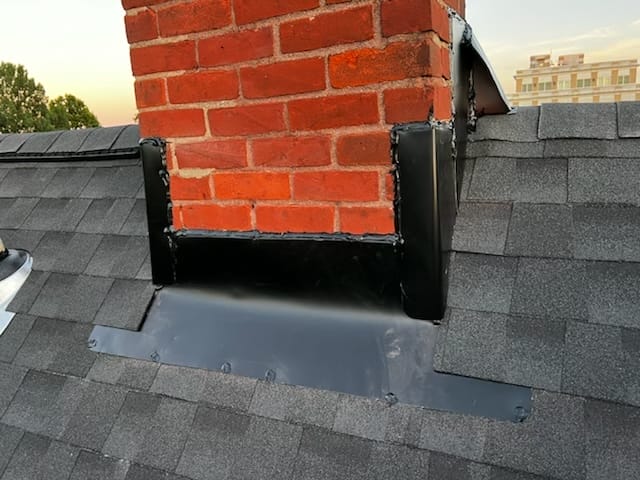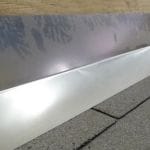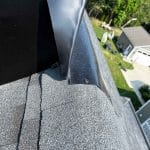Roof Flashings
In Cincinnati Ohio, roof flashings are one of the most important components of a healthy roof system. And since they are so important, you would think extra care and time would be dedicated to them. But the sad truth is it’s not. Poorly installed roof flashings can be noted in so many roofs in Cincinnati, this greatly compromises the roof’s integrity and completely eliminates warranties. That is why Origin Exteriors takes extra time and dedication to these finer details and always replaces every flashing component on new roof installations. We do this because it helps homeowners save hundreds of dollars in the long run and because it’s the right thing to do.
What are roof flashings?
Roof flashings are pieces of metal or aluminum used to waterproof any area where water can potentially enter.
These areas include;
- Rakes (Drip Edge)
- Eaves (Gutter Apron)
- Pipe vents (Pipe Boots)
- Walls (Roof-to-Wall)
- Skylights (Step Flashing)
- Chimneys (Chimney Flashing)
- Valleys (Valley Flashing)
All these types of flashings play a critical role in directing water away from the roof and into the gutters. If not installed correctly and precisely, these flashings can lead to leaks into the attic space and the home. To determine an excellent flashing material, always look for the gauge of the metal, the higher the number the better the material. Good gauge material ranges from 26-32 gauge.
Rakes (Drip Edge)
Drip Edge is the T-shaped metal flashing that is installed on all rakes of the roof to help prevent water from entering behind the fascia, creating a water-tight seal and generally has a flange that is bent away from the fascia. Here In Cincinnati the (IRC) International Residential Code, states that all homes must have drip edge installed. Drip edge is available in various colors and sizes. The typical colors are white, black, and bronze with the standard dimensions of 2 Inch and 3/4 nailing zone and 1 Inch and 1/2 drop.
Eaves (Gutter Apron)
Gutter Apron is the L-shaped metal flashing installed on all the roof eaves and moves water away from the roof line and into the gutters. It is designed to protect your roof lines from rotting because water tends to travel all around the surface it touches and with a gutter apron, it prevents just that and redirects water into the gutters.
Pipe Vents (Pipe Boots)
Pipe Boots are flashings that go around the base of pipes coming out of the roof and waterproofs them. Pipes are open sections on the roof; leaks will definitely be present if not sealed properly with this boot flashing. Good quality boots are recommended because UV rays will over time break down the neoprene synthetic rubber section of the boot which in turn causes cracks and leaks. A good quality boot will last you longer and save you money in the long run.
Walls (Roof-to-Wall)
Roof-to-wall, also known as headwall flashing or apron flashing, is the flashing that is used in areas where the roof plane meets a vertical surface like a wall or a dormer. Roof-to-wall flashing prevents leaks by guiding water from the walls into the roof system and is installed behind the siding and on top of the roof system. Properly secured with nails and sealers. Origin Exteriors uses 32 gauge metal or 26 gauge aluminum to bend all roof-to-wall flashings and are specifically customized individually for every home.
Skylights (Step Flashing)
Step Flashing is used against walls and other penetrations on the roof such as skylights to redirect water to the course below it. Its name states specifically how it’s installed, in the form of steps, with an extension of 2 inches past the course above it to help direct water down the roof. The material we recommend is aluminum because of its flexibility and ability to adjust to tight spots and because of its anticorrosive properties. Various colors are available, with the correct color always being the same color as the shingles.
Chimneys (Chimney Flashing)
Chimneys are known to leak because many are made from bricks. The best way to fight water infiltration through the chimney is with chimney flashing. Water will travel down the chimney and enter through the base, perforating the roof deck and crawling its way into your living space down below. Counter flashing must be installed, this means grinding down the mortar joints, approximately 1 inch to cover the head of the flashings down below. Step flashing can be used as the flashing below, but we prefer to fabricate custom metal for these sections to assure a waterproofed chimney. The metal of choice is aluminum because it does not rust or deteriorate as fast as traditional metal. One chimney project done by us will last you the whole lifetime of the roof. Now that’s good chimney work.
Valleys (Valley Flashing)
Valleys must always be accompanied by a waterproofed membrane down below, ice and water shield. This is a membrane that must be installed by code and functions as an extra layer of protection. Valleys are known to accumulate debris and snow in our area, therefore you can never be too careful. This then gets followed by a metal flashing lining that is durable and elegant. Two lines of chalk are then taken and the shingles are placed on the sides of the metal lining to prevent water from entering the shingle courses.
What should I do if one of my flashings is leaking?
Get in contact with us as soon as possible. Origin Exteriors is dedicated to excellence and to creating things that last. All flashings should be replaced the moment a new roof is installed. But if they are not or if they fail early, get in contact with us as soon as possible to avoid further damage and help you save money.
In some cases, flashings will not leak, but the only way to verify this is through a qualified inspection. Our roofers at Origin Exteriors are certified roofers that have many years in the trade and are qualified to detect leaks, have us take care of the issue, and avoid confusion or headaches in finding the problem yourself. And as an additional bonus, they are completely complementary, we are here to help.
How much are roof flashing repairs?
Roof Flashings are fairly inexpensive and they should not be costly if they are being installed with a new roof. It’s easier to install them when everything is open and exposed. The nightmare begins when the roof looks great and the flashing is failing. In certain situations, various shingles must be removed and replaced to get to just one flashing piece. Situations like this can lead to a flashing repair costing 3-5 times more than if it had been replaced new the first time around when everything was completely open and exposed. Remember to always hire a certified roofer to avoid situations such as these.
How long will my roof flashings last?
In general terms, a good flashing should last between 25-40 years. It is always best to replace the flashings during a new roof installation to prevent failures before a new roof is needed. This applies to all the flashings: Rakes (Drip Edge), Eaves (Gutter Apron), Pipe vents (Pipe Boots), Walls (Roof-to-Wall), Skylights (Step Flashing), Chimneys (Chimney Flashing), and Valleys (Valley Flashing).
What’s the best material to use for flashings?
Various metals work best for different situations, but aluminum has proved to be of great trust. Aluminum has anti-corrosive properties, can retain shine and color better and, when installed properly, performs better than galvanized metals.






